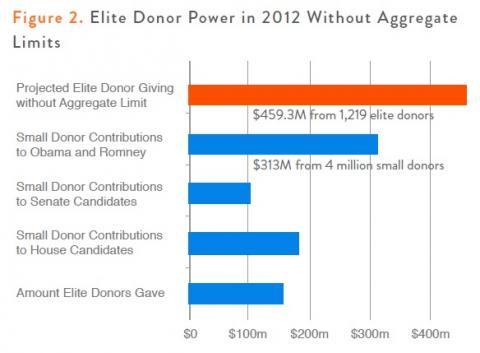MCCUTCHEON COULD ADD OVER $1 BILLION IN CONTRIBUTIONS TO NEXT FOUR ELECTIONS
McCutcheon v. FEC Could Significantly Increase the Giving of a Small Handful of Donors
We project that striking the aggregate limit would bring more than $1 billion in additional campaign contributions from elite donors through the 2020 election cycle.
Ohio PIRG, DEMOS

This term, the Supreme Court is considering a challenge to aggregate contribution limits in a case called McCutcheon v. FEC. The current limit on what one person may contribute to all federal candidates, parties and PACs is $123,200. Absent this limit, one wealthy donor would be permitted to contribute more than $3.5 million to a single party’s candidates and party committees (plus a virtually unlimited amount to supportive PACs).
Under current case law, the Supreme Court should uphold aggregate contribution limits as a decades-old protection against corruption, the appearance of corruption, and circumvention of base contribution limits.
But the Roberts Court has been willing to toss precedent aside to gut campaign finance laws in the past. So it’s worth asking, what would be the practical effect if the Court strikes a federal contribution limit for the first time?
“MCCUTCHEON MONEY”
We project that striking aggregate contribution limits would bring more than $1 billion in additional campaign contributions from elite donors through the 2020 election cycle. Elite donors are defined here as those who gave (or are projected to give) at, over, or within 10% of the aggregate contribution limit.

This figure does not represent a sea change when compared with existing spending levels, but it would significantly strengthen the power of a tiny number of elite donors compared with small contributors. And striking aggregate limits would increase elite donors’ influence over elected officials by making officeholders increasingly dependent upon this small slice of the population for campaign funds.
MORE POWER FOR ELITE DONORS
In 2012, just 1,219 elite donors contributed $155.2 million to candidates, parties, and PACs. Without an aggregate contribution limit, we estimate that these donors would have contributed $459.3 million in the 2012 cycle. As a point of reference, this projected sum is 47% more than all of the funds that President Obama and Governor Romney raised combined from at least 4,040,442 small donors.

The undue and increasing power of large donors fuels the public’s mistrust of government and the widespread appearance of corruption that aggregate contribution limits are intended to combat. Government in the U.S. is strongly responsive to the public policy preferences of those who can afford to make large campaign contributions, and almost completely unresponsive to the priorities of the general public. Americans recognize this, and believe it is due to the influence of large campaign contributions.6 This has fed the widespread belief that our government is corrupt and contributed to the lowest levels of confidence in Congress on record.
To view Demos’ and U.S. PIRG’s amicus brief to the Supreme Court showing how government’s responsiveness to large donors fuels the appearance of corruption, visithttp://www.demos.org/sites/default/files/publications/mccutcheon_sc_demo….